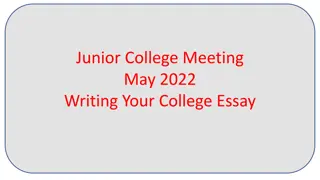Mastering Essay Writing: Key Elements and Structuring Tips
Learn the essential components of an effective essay, including the importance of spelling, grammar, clear arguments, and supporting evidence. Structure your essay with a strong introduction, well-supported main body, and a compelling conclusion. Understand how to incorporate references and present a coherent argument that addresses the essay question.
Download Presentation

Please find below an Image/Link to download the presentation.
The content on the website is provided AS IS for your information and personal use only. It may not be sold, licensed, or shared on other websites without obtaining consent from the author.If you encounter any issues during the download, it is possible that the publisher has removed the file from their server.
You are allowed to download the files provided on this website for personal or commercial use, subject to the condition that they are used lawfully. All files are the property of their respective owners.
The content on the website is provided AS IS for your information and personal use only. It may not be sold, licensed, or shared on other websites without obtaining consent from the author.
E N D
Presentation Transcript
Which of these would you find in a good essay? Good spelling, punctuation and grammar Bullet points An introduction and conclusion Copying from other sources Spelling mistakes and errors Paragraphs Clear points that link back to the question Writing everything you know on the subject Using research from experts to back up your ideas Answering the question with a clear opinion References that show where your information came from
Essays are about arguments Your essay question or title asks you to express your point of view on the subject. There is no right or wrong answer. Your argument must be supported by evidence: statistics, examples, evidence drawn from different sources. Can you consider other points of view, and show why your argument is the most convincing?
Structuring an essay What should you include in each part of your essay? Introduction Main Body Conclusion Bibliography/Reference List Presentation
Structuring a successful essay Introduction: Introduce the topic of your essay What? When? Who? Introduce the question you are answering and how you will answer it. Let the reader know what you will argue. This is sometimes referred to as signposting and helps the reader to know what to expect.
Structuring a successful essay Main Body: Each point or section of your argument should use a new paragraph. Support your ideas with evidence: key facts, examples, statistics and sources that you have explored in your course to prove your point (and remember to reference your evidence! Analyse evidence using sentence starters like This suggests that or This evidence demonstrates Aim for a balancedargument by considering different points of view. Link back to the question or title of your essay at the end of each paragraph make sure you stay focussed on the specific topic.
Structuring a successful essay Conclusion: Summarise the key points made in your essay Restate your main arguments be convincing! References/Bibliography: Include a list of references to show your reader where you found your evidence Acknowledge which facts, statistics and ideas are not your own and where you have taken them from (books, articles, newspapers etc.) Presentation: Good spelling, punctuation and grammar proofread to check for errors. Use the same fonts, spacing and paragraphs.
Introduction, Main Body or Conclusion where would each part go? However, there are many reasons that young people may feel safer with their mobile phones at school. For example, they can get in touch with family members if they need to before or after school. Additionally, an Oxford University study found that using their phones was no worse for teenagers mental health than eating potatoes. This essay explores the idea that mobile phones should be banned in schools. In order to discuss the statement, this essay will present evidence which supports and denies this claim in order to make a balanced judgement based on these findings. In conclusion, schools could ban mobile phones from being seen in lessons to prevent disruption to lessons, but there is little evidence to support a full ban, as pupils may need mobile phones in certain situations. One argument to support mobile phones being banned in school is that they can cause disruption to lessons. A survey with a teaching union, NASUWT, estimates that 46% of teachers want mobile phones banned as they cause indiscipline, with some pupils answering phones in lessons or the noise distracting pupils. This figure shows that a large amount of teachers support a ban, but it is not half of all teachers.
Introduction, Main Body or Conclusion where would each part go? This essay explores the idea that mobile phones should be banned in schools. In order to discuss the statement, this essay will present evidence which supports and denies this claim in order to make a balanced judgement based on these findings. One argument to support mobile phones being banned in school is that they can cause disruption to lessons. A survey with a teaching union, NASUWT, estimates that 46% of teachers want mobile phones banned as they cause indiscipline, with some pupils answering phones in lessons or the noise distracting pupils. This figure shows that a large amount of teachers support a ban, but it is not half of all teachers. However, there are many reasons that young people may feel safer with their mobile phones at school. For example, they can get in touch with family members if they need to before or after school. Additionally, an Oxford University study found that using their phones was no worse for teenagers mental health than eating potatoes. In conclusion, schools could ban mobile phones from being seen in lessons to prevent disruption to lessons, but there is little evidence to support a full ban, as pupils may need mobile phones in certain situations.
Analysis and evidence in essay writing Good essays use evidence to support their argument. The best essays analyse this evidence rather than simply describing what the evidence says. Description = what Analysis = why? So what? Why is the evidence important?
Description vs. analysis Statistics showing the number of followers of different pet accounts demonstrate that dogs are more popular on Instagram than other types of pet. Of the top 15 pet accounts, 8 are dogs, including 3 of the top 5. In contrast, only 4 of the top 15 accounts relate to cats. There are some unusual animals among the list of dogs and cats such as a fox and a raccoon, suggesting that some people enjoy looking at less typical pets on social media. The pet with the most followers on Instagram is a dog called jiffpom, with over 6 million followers. This is nearly double the number of followers of the second highest, a cat called nala_cat. There are 13 pet accounts that have over 1 million followers.
Using analysis in your essay: PEEL 1. Point state your point 2. Evidence give specific evidence to support your point 3. Explain explain how your evidence proves your point 4. Link link back to the main point/question of your essay
Essay question: Are dogs really mans best friend? Point: Many people around the world use social media to follow the lives of dogs. Evidence: Statistics from Instagram show that the most popular pet account is a dog called Jiffpom , with over 6 million followers. Of the top 15 pet accounts, 8 are dogs, including 3 of the top 5. In contrast, only 4 of the top 15 accounts relate to cats. Evaluate: This demonstrates that Instagram users prefer looking at pictures of dogs over those of cats. Link: This evidence therefore suggests that dogs are the most popular pets and as a result can be considered man s best friend .
Essay Writing Easy Wins 1. Prepare an outline or mind map your ideas. 2. Clear structure. 3. Analyse, don t describe! 4. Use relevant evidence and research to support your points. 5. Link it back to the question
Tutors to Edit: We recommend some of the following activities: Ask pupils to use a paragraph from the essay structuring task on slide 8/9 and identify where the author is using analysis. (lowest challenge) Use PEEL to discuss the paragraphs from the essay structuring task on slide 8/9. These are broken down into their PEEL components on the following slide Select one source/piece of evidence from your course. Pupils to discuss in pairs how they could incorporate this into their essay, using PEEL. Alternatively, pairs could each work on a different source and then feed back to the group. Ask pupils to take a portion of their draft assignment and evaluate what they have done well/what they want to improve when considering PEEL. Then ask them to try re-writing one paragraph, based on this. Use a final assignment from a previous placement if you have one, or other anonymised sample essay: select two essays and ask pupils to assess how well they apply the ideas from PEEL in each essay (higher challenge) ask pupils to use the mark scheme to give feedback on what the final assignment did well, and what they might have done to improve. Pupils should be encouraged to use PEEL to support the feedback they might want to give (highest challenge) The worksheet summarises key information about this skill to support any task or activity you create
PEEL in practice This essay explores the idea that mobile phones should be banned in schools. In order to discuss the statement, this essay will present evidence which supports and denies this claim in order to make a balanced judgement based on these findings. One argument to support mobile phones being banned in school is that they can cause disruption to lessons. A survey with a teaching union, NASUWT, estimates that 46% of teachers want mobile phones banned as they cause indiscipline, with some pupils answering phones in lessons or the noise distracting pupils. This figure shows that a large amount of teachers support a ban, but it is not half of all teachers. However, there are many reasons that young people may feel safer with their mobile phones at school. For example, they can get in touch with family members if they need to before or after school. Additionally, an Oxford University study found that using their phones was no worse for teenagers mental health than eating potatoes. In conclusion, schools could ban mobile phones from being seen in lessons to prevent disruption to lessons, but there is little evidence to support a full ban, as pupils may need mobile phones in certain situations.























